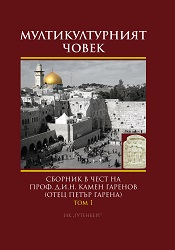Църква "Св. Никола" в с. Гинци
St. Nichilas Church in Gintsi village
Author(s): Zdravka Kosturkova
Subject(s): History, Archaeology, Cultural history, Local History / Microhistory, Middle Ages, Theology and Religion, 6th to 12th Centuries, 16th Century, 17th Century, 18th Century, 19th Century, History of Religion
Published by: Издателска къща "Гутенберг"
Keywords: Medieval churches; Medieval Age; Balkan history; History; Religion;
Summary/Abstract: The village of Gintsi is located in Western Bulgaria, at the foothills of the Western Balkan Range and at about 50 km of Sofia. Once a road connecting Moesia and the river Danube with Sardica and Macedonia used to pass through the village. There were also fortifications around it, as evidenced by the toponym "Kaleto", relevant to two elevations at both sides of the route to Petrohan pass. According to a record dated from 1490, the village had an entirely Christian population, as did the entire area in the vicinity of Sofia. A Turkish register shows that the church in the village, that can be dated from the Middle Ages, continued to exist. According to its plan, the St. Nicholas of Myra belongs to the most widespread type of churches in Bulgarian lands in the Middle Ages and the National Revival, the single-naved basilica. The church has a semi-circular central apse inside and out, a naos and a narthex (added later). The entrance is one from the west, through the narthex into the naos. It has a barrel vault and has a gable roof with wooden casing and tiles, completely in the style of West Bulgarian single-naved churches in the period from the end of the 12-th to the 19-th century. The building technique is traditional for West Bulgarian lands. The material used was hewn and river stone, joint with white mortar. The church was decorated with murals. There were three distinctive period of decoration, with almost nothing remaining from the first murals. The murals are in three artistic layers.
- Page Range: 183-191
- Page Count: 9
- Publication Year: 2016
- Language: English, Bulgarian
- Content File-PDF

